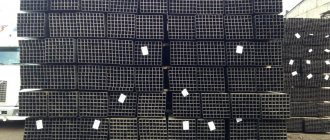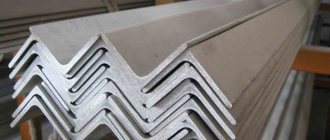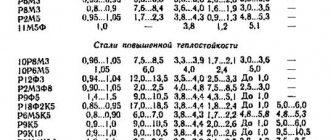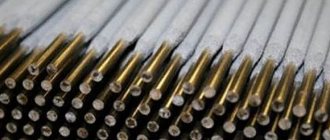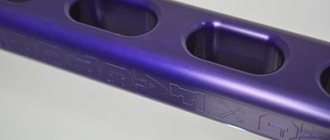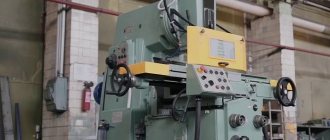Alloy VT8M-1 Alloy VT32 Alloy VT35 Alloy VT4 Alloy VT41 Alloy VT5 Alloy VT5-1 Alloy VT6 (VT6sv.) Alloy VT6S Alloy VT6ch Alloy VT8 Alloy VT8-1 Alloy VT3-1 Alloy VT9 Alloy OT4 Alloy OT4-0 Alloy OT4-1 Alloy OT4-2 Alloy PT-1M Alloy PT-3V Alloy PT-7M Alloy SPT-2 Alloy TS5 Alloy TS6 Alloy VT15 Alloy 14 Alloy 19 Alloy 27 Alloy 2V Alloy 37 Alloy 3M Alloy 40 Alloy 5V Alloy AT3 Alloy AT6 Alloy VT14 Alloy VT25U Alloy VT16 Alloy VT18 Alloy VT18U Alloy VT2 (VT2sv.) Alloy VT20 Alloy VT20-1 (VT20-1sv.) Alloy VT20-2 (VT20-2sv.) Alloy VT22 Alloy VT22I Alloy VT23
Description
VT20 alloy is used : for the production of semi-finished products (sheets, tapes, foil, strips, plates, rods, profiles, pipe blanks and pipes, forgings and stamped blanks up to 250 mm thick) by deformation, as well as ingots; welded rings from hot-rolled and extruded profiles, as well as solid-rolled rings; corrosion-resistant parts that operate for a long time at temperatures up to +500 °C; for the manufacture of wing skins, parts and welded assemblies in the aircraft industry, operating for a long time at temperatures from -70 to +450 °C (6000 hours), up to +500 °C (3000 hours).
Note
Pseudo a-alloy VT20 belongs to the Ti-Al-Zr-Mo-V system. The fairly high aluminum content provides significant strength and heat resistance to this alloy. Its ductility and manufacturability during pressure treatment are lower than those of OT4 type alloys. However, it deforms well when hot. In its sheet version, this alloy is second only to VT18U alloy in its heat-resistant characteristics. The alloy welds well with all types of welding used for titanium alloys. The mechanical properties of the welded joint are not inferior to the properties of the base metal. Alloy VT20 can be welded with titanium alloys VTZ-1, OT4, OT4−1, VT5−1, VT6, VT14, VT5L, VT21L. This alloy is also supplied in the form of shaped castings under the brand name VT20L.
Titanium - alloy and grades
Titanium (Titanium; designated by the symbol Ti) is an element of the secondary subgroup of the fourth group, the fourth period of the periodic table of chemical elements of D. I. Mendeleev, with atomic number 22.
The simple substance titanium is a light, durable metal of a silvery-white color. It exists in two crystalline modifications: α-Ti with a hexagonal close-packed lattice, β-Ti with cubic body-centered packing, the temperature of the polymorphic transformation α↔β is 883°C. Melting point 1660±20°C. Titanium has a Brinell hardness of 175 MPa.
Titanium is in 10th place in terms of prevalence in nature. in the earth's crust - 0.57% by weight, in sea water - 0.001 mg/l. In ultramafic rocks 300 g/t, in basic rocks - 9 kg/t, in acidic rocks 2.3 kg/t, in clays and shales 4.5 kg/t. In the earth's crust, titanium is almost always tetravalent and is present only in oxygen compounds. Not found in free form.
The industrial method of titanium production consists of enrichment and chlorination of titanium ore, followed by reduction of titanium tetrachloride with magnesium metal. The resulting titanium sponge is marked according to the hardness of samples specially melted from it.
Obtained as a result of sequential crushing of the sponge, pressing, sintering and remelting of briquettes, technical titanium is marked depending on the impurity content. Therefore, the content of each of these impurities is limited to ~0.02-0.06%. Iron and silicon influence the properties similarly, but to a lesser extent.
A particularly harmful impurity in titanium and single-phase a-titanium alloys is hydrogen. In the presence of hydrogen, thin, brittle sheets of hydride phase precipitate along the grain boundaries, causing significant brittleness. Hydrogen embrittlement is most dangerous in welded structures due to the presence of internal stresses in them.
The permissible hydrogen content in technical titanium and single-phase alloys is in the range of 0.008-0.012%.
Basic properties of titanium
- Color: Silver White
- Density: 4.54 g/cm³
- Melting point: 1668°C
- Boiling point: 3260°C
- Thermal conductivity: 21.9 W/(m K)
- Atomic number: 22
- Atomic mass: 47.9
- Specific heat of fusion: 358 kJ/kg
- Specific heat capacity (at 20°C): 0.54 kJ/(kg.°C)
- Elastic modulus: 112 GPa
The mechanical properties of titanium largely depend on the content of impurities, especially H, O, N and C, which form interstitial solid solutions and intermediate phases with titanium: hydrides, oxides, nitrides and carbides.
A small content of oxygen, nitrogen, carbon increases hardness and strength, but at the same time ductility is significantly reduced, corrosion resistance is reduced, weldability, solderability and stampability deteriorate. Titanium has high strength and specific strength in deep cold conditions.
Technical titanium is well processed by pressure at 20-25°C and elevated temperatures. All types of pressed and rolled semi-finished products (sheets, pipes, wire, forgings, etc.) are made from it. Forging is carried out at a temperature of 1000-750°C, hot rolling - 100°C below the forging temperature.
Hot rolling produces sheets with a thickness of more than 6 mm; sheets of smaller thickness are produced by cold rolling or heating to 650-700°C. Pressing temperature 950-1000°C. Titanium can be welded well by argon arc and all types of resistance welding. The weld has a good combination of strength and ductility.
The strength of the weld is 90% of the strength of the base metal.
Titanium is difficult to cut and sticks to the tool, which leads to rapid wear. Machining titanium requires tools made of high-speed steel and hard alloys, low cutting speeds with high feed and depth of cut, and intensive cooling. A disadvantage of titanium is also its low anti-friction properties.
Titanium alloys
The advantages of titanium alloys compared to titanium are higher strength and heat resistance with fairly good ductility, high corrosion resistance and low density.
Titanium in the form of alloys is the most important structural material in aircraft, rocket and shipbuilding. The most common titanium alloy in the world is the Ti-6Al-4V alloy, which in the Russian classification is designated VT6.
For the manufacture of parts using powder technology, alloys VT5, VT5-1, OT4, VTZ-1 and others are used.
According to manufacturing technology, titanium alloys are divided into wrought, cast and powder.
According to their mechanical properties, titanium alloys are divided into alloys of normal strength, high-strength, heat-resistant, and increased ductility.
Based on their ability to be strengthened by heat treatment, they are divided into those that can be strengthened and those that cannot be strengthened by heat treatment; According to their structure in the annealed state, they are classified into a-, pseudo-a, a + p, pseudo-p and p-alloys.
Buy titanium
Application of titanium alloys
- In aircraft manufacturing, rocket engineering: frame parts, casing, fuel tanks, jet engine parts, compressor disks and blades, air intake parts, parts of second and third stage rocket engine housings, etc.
- In shipbuilding: hull plating of ships and submarines, welded pipes, propellers, pump parts, etc.
- In the chemical industry: reactors for aggressive media, pumps, coils, centrifuges, etc.
- In electroplating: chrome plating baths, anode baskets, heat exchangers, pipelines, suspensions, etc.
- In the gas and oil industry: filters, valve seats, tanks, settling tanks, etc.
- In cryogenic technology: parts of refrigerators, compressor pumps, heat exchangers, etc.
- In the food industry: separators, refrigerators, food containers, tanks, etc.
- In the medical industry: instruments, external and internal prostheses, intraosseous fixators, clamps, etc.
Grades and classes of titanium
Titanium sponge
| TG-100 | TG-110 | TG-120 | TG-130 | TG-150 |
| TG-90 | TG-TV |
Titan technical
| VT1-0 | VT1-00 | VT1-1 |
Titanium casting alloy
| VT14L | VT1L | VT20L | VT21L | VT3-1L |
| VT5L | VT6L | VT9L |
Titanium wrought alloy
| AT-6 | VT14 | VT15 | VT16 | VT20 |
| VT22 | VT23 | VT3-1 | VT5 | VT5-1 |
| VT6 | VT6S | VT9 | OT4 | OT4-0 |
| OT4-1 | PT3V | PT7M | TS6 |
Standards
| Name | Code | Standards |
| Non-ferrous metals, including rare ones, and their alloys | B51 | GOST 19807-91, OST 1 90000-70, OST 1 90013-81, OST 1 90002-86 |
| Sheets and strips | B53 | GOST 22178-76, GOST 23755-79, OST 1 90218-76, OST 1 90024-94 |
| Rods | B55 | GOST 26492-85, OST 1 90266-86, OST 1 90173-75, OST 1 90107-73, OST 1 90006-86 |
| Blanks. Blanks. Slabs | B31 | OST 1 90426-92 |
| Long and shaped rolled products | B52 | OST 1 92039-75, OST 1 92051-76, OST 1 92064-77, OST 1 90105-73, OST 1 90313-81, OST 1 90320-82, OST 1 90325-82, OST 1 90328-82 |
| Pipes made of non-ferrous metals and alloys | B64 | TU 1-5-127-73 |
Characteristics of titanium-based alloys, metal properties and applications
Titanium was originally named "gregorite" by British chemist Reverend William Gregor, who discovered it in 1791. Titanium was then independently discovered by the German chemist M.H.
Klaproth in 1793. He named it titan after the Titans of Greek mythology - "the embodiment of natural strength."
It was not until 1797 that Klaproth discovered that his titanium was an element previously discovered by Gregor.
Titanium is a chemical element with the symbol Ti and atomic number 22. It is a shiny metal with a silvery color, low density and high strength. It is resistant to corrosion in seawater and chlorine.
The element is found in a number of mineral deposits, mainly rutile and ilmenite, which are widespread in the Earth's crust and lithosphere.
Titanium is used to produce strong light alloys. The metal's two most useful properties are corrosion resistance and its hardness-to-density ratio, the highest of any metallic element. In its unalloyed state, this metal is as strong as some steels, but less dense.
Physical properties of metal
It is a strong metal with low density, quite ductile (especially in an oxygen-free environment), shiny and metalloid white. Its relatively high melting point of over 1650 °C (or 3000 °F) makes it useful as a refractory metal. It is paramagnetic and has fairly low electrical and thermal conductivity.
On the Mohs scale, the hardness of titanium is 6. According to this indicator, it is slightly inferior to hardened steel and tungsten.
Commercially pure (99.2%) titanium has an ultimate tensile strength of about 434 MPa, which is similar to common low-grade steel alloys, but titanium is much lighter.
Chemical properties of titanium
Like aluminum and magnesium, titanium and its alloys immediately oxidize when exposed to air. It reacts slowly with water and air at ambient temperatures because it forms a passive oxide coating that protects the bulk metal from further oxidation.
Atmospheric passivation gives titanium excellent corrosion resistance almost equivalent to platinum. Titanium is able to resist attack from dilute sulfuric and hydrochloric acids, chloride solutions and most organic acids.
Titanium is one of the few elements that burns in pure nitrogen, reacting at 800°C (1470°F) to form titanium nitride.
Due to their high reactivity with oxygen, nitrogen and some other gases, titanium filaments are used in titanium sublimation pumps as absorbers for these gases.
These pumps are inexpensive and reliably produce extremely low pressures in ultra-high vacuum systems.
Common titanium-containing minerals are anatase, brookite, ilmenite, perovskite, rutile and titanite (sphene). Of these minerals, only rutile and ilmenite are of economic importance, but even these are difficult to find in high concentrations.
Titanium is found in meteorites and has been found in the Sun and M-type stars with surface temperatures of 3200°C (5790°F).
Currently known methods for extracting titanium from various ores are labor-intensive and expensive.
Production and manufacturing
Currently, about 50 grades of titanium and titanium alloys have been developed and used. Today, 31 classes of titanium metal and alloys are recognized, of which classes 1–4 are commercially pure (unalloyed).
They differ in tensile strength depending on oxygen content, with class 1 being the most ductile (lowest tensile strength with 0.18% oxygen) and class 4 the least ductile (highest tensile strength with 0.40% oxygen). ).
The remaining classes are alloys, each of which has specific properties:
- plastic;
- strength;
- hardness;
- electrical resistance;
- specific corrosion resistance and their combinations.
In addition to these specifications, titanium alloys are also manufactured to meet aerospace and military specifications (SAE-AMS, MIL-T), ISO standards and country-specific specifications, as well as end-user requirements for aerospace, military, medical and industrial applications.
A commercially pure flat product (sheet, slab) can be easily formed, but processing must take into account the fact that the metal has a "memory" and a tendency to bounce back. This is especially true for some high-strength alloys.
Titanium is often used to make alloys:
- with aluminum;
- with vanadium;
- with copper (for hardening);
- with iron;
- with manganese;
- with molybdenum and other metals.
Areas of use
Titanium alloys in sheet, plate, rod, wire, and casting form find applications in industrial, aerospace, recreational, and emerging markets. Powdered titanium is used in pyrotechnics as a source of bright burning particles.
Because titanium alloys have a high tensile strength-to-density ratio, high corrosion resistance, fatigue resistance, high crack resistance, and the ability to withstand moderately high temperatures, they are used in aircraft, armor, naval vessels, spacecraft, and missiles.
For these applications, titanium is alloyed with aluminum, zirconium, nickel, vanadium and other elements to produce a variety of components, including critical structural members, firewalls, landing gear, exhaust pipes (helicopters) and hydraulic systems. In fact, about two-thirds of titanium metal produced is used in aircraft engines and frames.
Because titanium alloys are resistant to seawater corrosion, they are used for propeller shafts, heat exchanger rigging, etc. These alloys are used in housings and components of ocean surveillance and monitoring devices for science and the military.
Specific alloys are used in oil and gas wells and nickel hydrometallurgy for their high strength. The pulp and paper industry uses titanium in process equipment exposed to aggressive environments such as sodium hypochlorite or wet chlorine gas (in bleaching). Other applications include ultrasonic welding, wave soldering.
Additionally, these alloys are used in automotive applications, especially in automobile and motorcycle racing where low weight, high strength and stiffness are essential.
Titanium is used in many sporting goods: tennis rackets, golf clubs, lacrosse shafts; cricket, hockey, lacrosse and football helmets, as well as bicycle frames and components.
Due to its durability, titanium has become more popular for designer jewelry (particularly titanium rings). Its inertness makes it a good choice for people with allergies or those who will be wearing jewelry in environments such as swimming pools.
Titanium is also alloyed with gold to produce an alloy that can be sold as 24 karat gold because 1% Ti alloyed is not enough to require a lower grade.
The resulting alloy is approximately the hardness of 14 karat gold and is stronger than pure 24 karat gold.
Precautionary measures
Titanium is non-toxic even in large doses . Whether in powder or metal filing form, it poses a serious fire hazard and, if heated in air, an explosion hazard.
Properties and applications of titanium alloys
Below is an overview of the most commonly found titanium alloys, divided into classes, their properties, advantages and industrial applications.
7th grade
Grade 7 is mechanically and physically equivalent to Grade 2 pure titanium, except for the addition of the intermediate element palladium, making it an alloy. It has excellent weldability and elasticity, the most corrosion resistance of all alloys of this type.
Class 7 is used in chemical processes and manufacturing equipment components.
Grade 11
Class 11 is very similar to Class 1, except for the addition of palladium to improve corrosion resistance, making it an alloy.
Other beneficial properties include optimum ductility, strength, toughness and excellent weldability. This alloy can be used especially in applications where corrosion is a problem:
- chemical treatment;
- production of chlorates;
- desalination;
- marine applications.
Ti 6Al-4V, class 5
Ti 6Al-4V alloy, or grade 5 titanium, is the most commonly used. It accounts for 50% of total titanium consumption worldwide.
Ease of use lies in its many advantages. Ti 6Al-4V can be heat treated to increase its strength. This alloy has high strength with low weight.
It is the best alloy for use in several industries such as aerospace, medical, marine and chemical processing. It can be used to create:
- aircraft turbines;
- engine components;
- aircraft structural elements;
- aerospace fasteners;
- high-performance automatic parts;
- sports equipment.
Ti 6AL-4V ELI, class 23
Class 23 - surgical titanium. Ti 6AL-4V ELI alloy, or grade 23, is a higher purity version of Ti 6Al-4V. It can be made from rolls, threads, wires or flat wires.
It is the best choice for any situation where a combination of high strength, low weight, good corrosion resistance and high toughness is required. It has excellent damage resistance.
It can be used in biomedical applications such as implantable components due to its biocompatibility, good fatigue resistance. It can also be used in surgical procedures to make the following structures:
- orthopedic pins and screws;
- ligature clamps;
- surgical staples;
- springs;
- orthodontic devices;
- cryogenic vessels;
- bone fixation devices.
12th grade
Titanium grade 12 has excellent high-quality weldability. It is a high-strength alloy that provides good strength at high temperatures. Grade 12 titanium has characteristics similar to 300 series stainless steels.
Its ability to be shaped in a variety of ways makes it useful in many applications. The alloy's high corrosion resistance also makes it invaluable for manufacturing equipment. Class 12 can be used in the following industries:
- heat exchangers;
- hydrometallurgical applications;
- chemical production at elevated temperatures;
- maritime and air components.
Ti5Al-2.5Sn
Ti 5Al-2.5Sn is an alloy that can provide good weldability with stability. It also has high temperature stability and high strength.
Ti 5Al-2.5Sn is mainly used in the aviation sector and also in cryogenic applications.
Chemical composition
| Standard | C | Si | Fe | N | Al | V | Ti | Mo | O | Zr | H |
| GOST 19807-91 | ≤0.1 | ≤0.15 | ≤0.25 | ≤0.05 | 5.5-7 | 0.8-2.5 | Remainder | 0.5-2 | ≤0.15 | 1.5-2.5 | ≤0.015 |
| OST 1 90013-81 | ≤0.1 | ≤0.13 | ≤0.25 | ≤0.05 | 5.5-7 | 0.8-2.5 | Remainder | 0.5-2 | ≤0.15 | 1.5-2.5 | ≤0.015 |
Ti is the basis. According to GOST 19807-91 and OST 1 90013-81, the total content of other impurities is ≤ 0.30%. The mass fraction of hydrogen is indicated for ingots. In the alloy, partial replacement of molybdenum with tungsten is allowed in an amount of no more than 0.3%. The total mass fraction of molybdenum and tungsten should not exceed the standards specified in the table for molybdenum. The mass fraction of chromium and manganese should not exceed 0.15% (in total). The mass fraction of copper and nickel should be no more than 0.10% (in total), including nickel no more than 0.08%.
Mechanical characteristics
| Section, mm | sТ|s0.2, MPa | σB, MPa | d5, % | d10 | y, % | kJ/m2, kJ/m2 | Brinell hardness, MPa | H.R.C. |
| Welded rings according to OST 1 90320-82 | ||||||||
| 5-10 | — | 930-1130 | ≥8 | — | — | ≥392 | — | — |
| Rolled sheets as delivered (samples across the rolling direction) | ||||||||
| — | — | ≥638 | — | — | — | — | — | — |
| Welded rings according to OST 1 90320-82 | ||||||||
| 10-20 | — | 930-1130 | ≥6 | — | — | ≥392 | — | — |
| Forgings and stampings weighing up to 200 kg after annealing | ||||||||
| — | — | ≥638 | — | — | — | — | — | — |
| Welded rings according to OST 1 90320-82 | ||||||||
| 5-10 | — | 880-1130 | ≥6 | — | — | ≥245 | — | — |
| Hot rolled rods. Annealing | ||||||||
| — | — | ≥687 | — | — | — | — | — | — |
| Welded rings according to OST 1 90320-82 | ||||||||
| 10-20 | — | 880-1130 | ≥4.5 | — | — | ≥245 | — | — |
| Hot rolled rods. Annealing | ||||||||
| — | — | ≥569 | — | — | — | — | — | — |
| Welded rings according to OST 1 90325-82 | ||||||||
| — | — | 930-1180 | ≥10 | — | ≥25 | ≥343 | — | — |
| — | — | 880-1180 | ≥5 | — | ≥12 | ≥245 | — | — |
| Welded rings according to OST 1 90328-82 | ||||||||
| 5-10 | — | 930-1130 | ≥8 | — | — | — | — | — |
| 10-20 | — | 930-1130 | ≥6 | — | — | ≥392 | — | — |
| 5-10 | — | 880-1130 | ≥4 | — | — | — | — | — |
| 10-20 | — | 880-1130 | ≥3 | — | — | ≥196 | — | — |
| Rolled sheets as delivered (samples across the rolling direction) | ||||||||
| 0.8-4 | — | 980-1180 | ≥9 | — | — | — | — | — |
| 4-10.5 | — | 980-1180 | ≥6 | — | — | — | — | — |
| Rolled sheets after annealing (samples across the rolling direction) | ||||||||
| 0.8-1.8 | — | 930-1130 | ≥12 | — | — | — | — | — |
| 1.8-4 | — | 930-1180 | ≥10 | — | — | — | — | — |
| 4-10.5 | — | 930-1180 | ≥8 | — | — | — | — | — |
| Aircraft engine blades manufactured by volumetric stamping, volumetric stamping using thermomechanical processing and volumetric stamping under isothermal conditions, including under conditions of superplasticity after annealing (small-sized (M) - projection area 20-250 cm2, medium-sized (C) - 250- 550 cm2, large-sized (K) - 550-1500 cm2) | ||||||||
| M, S, K | — | 930-1130 | ≥10 | — | ≥25 | ≥392 | 255-341 | 28-38.5 |
| Plates are in delivery condition in accordance with GOST 23755-79. Annealing (transverse samples) | ||||||||
| 11-60 | — | 900-1130 | — | ≥6 | ≥12 | ≥294 | — | — |
| 60-100 | — | 880-1130 | — | ≥5 | ≥10 | ≥294 | — | — |
| Plates according to OST 1 90024-94 are in delivery condition. Annealed samples (transverse) | ||||||||
| 11-60 | — | 930-1130 | — | ≥6 | ≥12 | ≥294 | — | — |
| 60-100 | — | 885-1130 | — | ≥5 | ≥10 | ≥294 | — | — |
| Forgings and stampings weighing up to 200 kg after annealing | ||||||||
| 101-250 | — | 883-1128 | ≥8 | — | ≥20 | ≥294 | 255-341 | — |
| 100 | — | 932-1128 | ≥10 | — | ≥25 | ≥392 | 255-341 | — |
| Hot-rolled annealed rods of normal quality according to GOST 26492-85 (longitudinal samples) | ||||||||
| 10-12 | — | ≥885 | ≥8 | — | ≥20 | — | — | — |
| 100-150 | — | ≥885 | ≥8 | — | ≥20 | ≥245 | — | — |
| 12-100 | — | ≥885 | ≥7 | — | ≥20 | ≥294 | — | — |
| High-quality hot-rolled annealed rods according to GOST 26492-85 (longitudinal samples) | ||||||||
| 10-12 | — | 930-1130 | ≥10 | — | ≥25 | — | — | — |
| 100-150 | — | 885-1130 | ≥8 | — | ≥20 | ≥294 | — | — |
| 12-25 | — | 930-1130 | ≥10 | — | ≥25 | ≥294 | — | — |
| 25-100 | — | 930-1130 | ≥10 | — | ≥25 | ≥392 | — | — |
| Forged square and round rods after annealing | ||||||||
| 140-250 | — | 883-1128 | ≥8 | — | ≥20 | ≥294 | 255-341 | — |
| — | 932-1128 | ≥9 | — | ≥25 | ≥392 | 255-341 | — | |
| Bar as delivered | ||||||||
| ≥840 | 950-1150 | ≥10 | — | ≥25 | ≥450 | 255-341 | — | |
| Pipe blank. Annealing | ||||||||
| 15x15 | ≥736 | 932-1128 | ≥10 | — | ≥25 | ≥392 | — | — |
Titanium alloys: nuances of heat treatment
Titanium is widespread on earth. After Al, Fe and Mg, it is the fourth most abundant metal present in the Earth's crust and is the ninth most abundant element on Earth.
Titanium alloys (TS) have a unique range of properties due to a combination of high strength and rigidity, impact strength and anti-corrosion properties, which provides a wide range of applications for working in environments with both low and high temperatures, allowing for weight reduction in aerospace structures and large equipment components .
General characteristics of the properties of titanium and its alloys
The atomic weight of Ti is 47.88. It is elastically rigid, about 115 GPa Young's modulus, durable, lightweight, resistant to corrosion processes. Ti and titanium alloys have tensile strengths in the range of 210-1380 MPa, which approaches the ultimate strength of many complex steels.
It has an extremely low density of approximately 60.0% of that of Fe. It can be strengthened by alloying with a solute. Ti is non-magnetic and has excellent heat transfer capabilities. One of its important properties of titanium alloys is its high melting point - 1725.0 C, that is, almost 200 C more than steel, and 1000 C more than Al.
Ti is passivated and therefore its alloys have a high degree of resistance to most mineral acids. It is non-toxic and compatible with biological tissues and minerals.
Excellent corrosion resistance and biocompatibility coupled with excellent strength have made them useful for the chemical industry and biomaterials. Ti is not a good conductor of electric current. If the conductivity of Cu is taken to be 100.
0%, then Ti will only have 3.1%, which means it is a pretty good resistor.
Titanium Ingot
Classification of groups
Ti alloys are divided into the following groups:
- High-strength structural - solid solutions, with an optimal ratio of strength characteristics and ductility.
- Heat-resistant titanium alloys are solid solutions with the required amount of additives that provide resistance in areas with high temperatures with a slight decrease in ductility.
- TS based on a chemical compound capable of competing with Ni alloys in a certain temperature range.
High-strength structural vehicles
High-strength alloys - VT-14, VT-22, VT-23, VT-15 (1000.0-1500.0 MPa).
VT-22 is a weldable vehicle with high strength characteristics and hardenability. It has found wide application in the manufacture of domestic aircraft: Il-76/86/96, An-72/74/124/224/148, Yak-42, MiG-29 and others. From this vehicle, large-sized parts are manufactured for the internal power set, chassis units and welded units, for example, cross-beams and beams of the main chassis bogies.
VT-22I, produced by a high-tech method of isothermal deformation under conditions of superplasticity, can ensure the production of thin-walled parts of complex configurations and guarantees reliable welding of titanium alloys. A high and stable level of mechanical properties is achieved by a homogeneous fine-grained structure, which reduces the labor intensity of machining parts by 35–40%.
Titanium Alloy Tubes for Heat Exchangers
Heat-resistant Ti alloys
Heat-resistant titanium alloys – VT3 1, VT8-1, VT-9, VT8M-1, VT-18, VT-25 (1000.0-1500.0 MPa).
VT8-1, VT8M-1 - these grades of titanium alloys are characterized by heat resistance, crack resistance and stability at T 400-550C. They have low sensitivity to local stresses and are used for aircraft engines with a long service life.
The domestic alloy VT-25 with a strength index of up to 1150.0 MPa, significantly exceeds foreign analogues, has the highest properties at temperatures up to 550.0C.
VT-18 has the most durable properties at temperatures up to 600.0C - the best among domestic alloys used in industry.
Chemical alloys
Intermetallic (chemical) titanium alloys are based on the so-called intermetallic phase. Of technical interest are TiAl, Ti3Al, Al3Ti and Ti2AlNb. The properties of intermetallic compounds are between ceramics and metals.
TiAl is a high-temperature titanium alloy that exhibits excellent properties such as heat resistance, oxidation and creep resistance, low density and high fatigue strength. At the same time, TiAl exhibits low ductility.
This must be taken into account when designing components and is a major barrier to widespread use in many applications.
The vehicle is used to produce forgings, billets, plates and sheets from TiAl. Complex castings are also available because it is used for some high temperature components in near pure form.
TiAl is of interest for applications such as jet engine blades, compressor wheels for turbochargers, automotive valves, and other heat-resistant components.
For high temperature applications requiring low weight, it is a good alternative to superalloys up to 850 C.
Marking of titanium alloys
There are two crystallographic forms of titanium that are taken into account when marking:
- Alpha titanium, in which the atoms are arranged in a crystal lattice;
- beta titanium, in which the atoms are arranged in a cubic crystal lattice (BCC).
Pure titanium exists in the alpha phase form at temperatures above 883 C and in the beta phase at temperatures below 883 C. The temperature of the allotropic transformation of alpha titanium into beta titanium is called the beta transus temperature. Alloying elements in TC can stabilize either the alpha phase or the beta phase of the alloy.
Aluminum (Al), gallium (Ga), nitrogen (N), oxygen (O) stabilize the alpha phase.
Molybdenum (Mo), vanadium (V), tungsten (W), tantalum (Ta), silicon (Si) stabilize the beta phase.
Titanium alloys are divided into four groups according to phase composition:
- Commercially pure and low-alloy vehicles. It consists of grains-phase and dispersed spheroidal particles of beta-phase. The small amounts of iron present in the alloys stabilize the beta phase and have relatively low mechanical strength and good corrosion resistance.
- Titanium alpha alloys consist exclusively of the alpha phase. They contain aluminum as the main alloying element that stabilizes the alpha phase. They have good fracture toughness and creep resistance combined with moderate mechanical strength that is maintained at elevated temperatures. Such vehicles are easily welded, but their performance in a hot state leaves much to be desired.
- Titanium alpha-beta alloys contain 4-6% beta phase stabilizers, so they consist of a mixture of both phases. Alpha-veta alloys are heat treated. They have high mechanical strength and good hot form. The creep resistance of such vehicles is lower than that of alpha alloys.
- Titanium beta alloys are rich in beta phase. They contain significant amounts of beta phase stabilizers, are heat treated to very high strength and have good hot shape. The ductility and fatigue strength of these vehicles under heat treatment conditions are low.
Titanium alloys are designated according to their compositions:
- Ti-5Al-2.5Sn identifies a titanium alloy containing 5% aluminum and 2.5% tin.
- Ti-6Al-4V identifies a Ti alloy containing 6% aluminum and 4% vanadium.
In parallel to this designation system, there are other designation systems for titanium alloys (ASTM, IMI, military system).
Production of titanium and its alloys
Titanium is produced using the Kroll process. The main steps include extraction, purification, sponge production, alloy creation, and molding. At the beginning of smelting, the manufacturer receives titanium concentrates from the mines.
Although rutile can be used in its natural form, ilmenite is processed to remove iron so that it contains at least 85% titanium dioxide. These materials are placed in a fluidized bed reactor along with chlorine and carbon gas.
The material is heated to 900 C and the subsequent chemical reaction produces impure titanium tetrachloride (TiCl4) and carbon monoxide. Next, the various unwanted metal chlorides that are formed must be removed.
The reacted metal is placed in large distillation vessels and heated. At this stage, impurities are separated using fractional distillation and precipitation. This step removes metal chlorides, including iron, vanadium, zirconium, silicon and magnesium.
The purified titanium tetrachloride is transferred as a liquid into a stainless steel reactor vessel. Magnesium is then added and the container is heated to a temperature of about 1100 C.
Argon is pumped into the tank to remove air and prevent oxygen or nitrogen from contaminating the alloy. Magnesium reacts with chlorine to form liquid magnesium chloride.
This leaves a solid titanium solid as the melting point of titanium is higher than in the reaction.
The titanium solid is removed from the reactor by drilling and then treated with water and hydrochloric acid to remove excess magnesium. The resulting solid is a porous metal called a sponge.
Pure titanium sponge can be converted into a usable alloy using a consumable electrode arc furnace. At this point, the sponge is mixed with various alloy additives. The exact ratio of sponge material to alloy is formulated in the laboratory prior to production.
This mass is then pressed into compacts and welded together to form a sponge electrode.
The sponge electrode is placed in a vacuum arc furnace for melting. In this water-cooled copper container, an electric arc is used to melt a sponge electrode to form an ingot. All air in the container is either removed (creating a vacuum) or the atmosphere is filled with argon to prevent contamination.
After the ingot is produced, it is removed from the furnace and inspected for defects. The surface can be conditioned at the customer's request. The bullion is then sent to the finished product buyer, where it can be crushed and processed into various products.
Titanium production
Application area
Titanium alloy, which has high corrosion resistance, high specific strength and good heat resistance, is used for various parts of the spacecraft, including the outer shell of the fuel tank and wings.
Combining light weight with high strength, titanium helps strengthen airframes and improve the performance of jet engines.
In the case of the space shuttle, titanium is used for many critical parts, including external fuel tank panels and wing parts.
Airplanes use large amounts of titanium alloy because it is lightweight and extremely strong at high temperatures. TC is used to strengthen the frame structure and contributes to the technical progress of jet engines.
Titanium alloys application:
- Installations for liquefied natural gas;
- seawater desalination plants;
- oil refineries;
- nuclear power plants;
- chemical tank trucks because the vehicle is lightweight, corrosion resistant, and extremely strong;
- heat exchangers that are used in extreme conditions of high temperature and high pressure;
- biomedical applications.
The huge advantages of titanium are its high strength-to-weight ratio and anti-corrosion properties. Combined with its non-toxic state and ability to effectively resist corrosion from body fluids, titanium has become the base metal for implants in the medical field, with a service life of over 20 years.
Another advantage of Ti for medical applications is its non-ferromagnetic property, which allows patients to be safely examined using MRI and NMR.
Titanium joint prosthesis
Description of mechanical symbols
| Name | Description |
| Section | Section |
| sT|s0.2 | Yield strength or proportional limit with tolerance for permanent deformation - 0.2% |
| σB | Short-term strength limit |
| d5 | Elongation after break |
| d10 | Elongation after break |
| y | Relative narrowing |
| kJ/m2 | Impact strength |
| H.R.C. | Rockwell hardness (diamond indenter, spheroconic) |
physical characteristics
| Temperature | E, GPa | r, kg/m3 | l, W/(m °С) | R, NOM m | a, 10-6 1/°С | C, J/(kg °C) |
| 20 | 112 | 4450 | 8 | 1110 | — | — |
| 100 | — | — | 88 | — | 83 | — |
| 200 | — | — | 102 | — | 83 | 587 |
| 300 | — | — | 109 | — | 9 | 628 |
| 400 | — | — | 122 | — | 92 | 67 |
| 500 | — | — | 138 | — | 93 | 712 |
| 600 | — | — | 151 | — | 95 | — |
